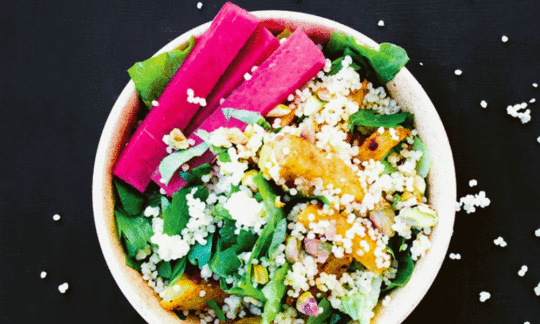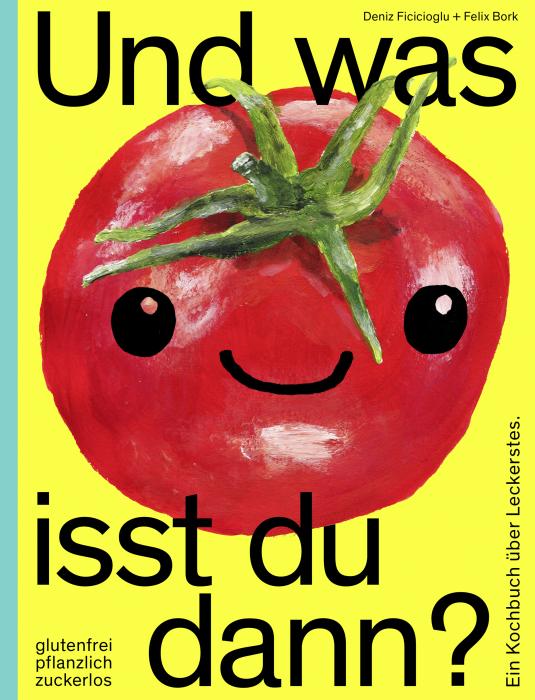Schawarma Salad with Millet, Pistachios, and Fresh Mint
vegan
Ingredients (for servings, )
Equipment
- mortar
- skillet (frying pan)
- stove
- citrus juicer (lemon squeezer)
- saucepan
Type of preparation
- cook
- fry
- chop or grind
- squeeze
- sauté
Preparation
Preparation
Wash the millet and place in a saucepan along with about three times as much lightly salted tap water. Bring to a boil, let cook for about 10 minutes, and then let simmer over low heat for 15–20 minutes. Stir occasionally. If necessary, remove from the heat before the end of the time and let stand until the end of the cooking time.While the millet is cooking, you can continue with the next step.
Alternatively, you can use precooked millet as is called for in the original recipe.
Cut the kohlrabi into vegetable sticks the size of french fries. Cook the kohlrabi fries in well-salted boiling water for about 15 minutes. Drain and let the kohlrabi cool.
Depending on the size, you will need about 1–2 kohlrabies.
While the kohlrabi is cooking, you can continue with the next step.
For the salad
In the meantime, wash the salad and cut into bite-size pieces. Finely chop the pistachios and herbs. Place the salad, pistachios, and herbs along with the precooked millet in a large bowl.The author uses salted pistachios here.
For the Asian spice mix
Coarsely grind the mustard seeds, cardamom, and coriander seeds using a mortar and pestle. Combine with the rest of the spices. Transfer the spice mix and cooled kohlrabi to a large bowl and stir until the kohlrabi is well coated with the spices.Cardamom is available in two colors (See notes), but the original recipe doesn’t call for a specific color.
Heat the sunflower oil in a skillet. Fry the kohlrabi on medium heat for 5–8 minutes, or until crispy.
For the dressing
Combine all of the ingredients for the dressing.The authors use unsweetened soy-rice milk as well as garlic oil made with olive oil. A recipe for garlic oil can be found in the same cookbook on page 75.
Garnishing and serving
Toss the salad with the dressing and kohlrabi. Mix well and serve immediately.If desired, you can garnish the salad with pink pickled turnips.
|
Nutritional Information per person
Convert per 100g
|
2000 kcal | |
|---|---|---|
| Energy | 314 kcal | 15.7% |
| Fat/Lipids | 19 g | 27.4% |
| Saturated Fats | 2.5 g | 12.5% |
| Carbohydrates (inc.dietary fiber) | 31 g | 11.4% |
| Sugars | 6.6 g | 7.4% |
| Fiber | 9.1 g | 36.2% |
| Protein/Albumin | 9.2 g | 18.4% |
| Cooking Salt (Na:270.0 mg) | 686 mg | 28.6% |
| Essential micronutrients with the highest proportions | per person | 2000 kcal | |
|---|---|---|---|
| Vit | Vitamin K | 89 µg | 118.0% |
| Vit | Vitamin C (ascorbic acid) | 63 mg | 79.0% |
| Vit | Vitamin B9, B11 (Folate, as the active form of folic acid) | 153 µg | 76.0% |
| Fat | Linoleic acid; LA; 18:2 omega-6 | 6.7 g | 67.0% |
| Min | Copper, Cu | 0.63 mg | 63.0% |
| Min | Manganese, Mn | 0.93 mg | 47.0% |
| Vit | Vitamin A, as RAE | 356 µg | 45.0% |
| Elem | Potassium, K | 790 mg | 40.0% |
| Vit | Vitamin B1 (Thiamine) | 0.44 mg | 40.0% |
| Vit | Vitamin B6 (pyridoxine) | 0.55 mg | 39.0% |
Detailed Nutritional Information per Person for this Recipe
The majority of the nutritional information comes from the USDA (US Department of Agriculture). This means that the information for natural products is often incomplete or only given within broader categories, whereas in most cases products made from these have more complete information displayed.
If we take flaxseed, for example, the important essential amino acid ALA (omega-3) is only included in an overarching category whereas for flaxseed oil ALA is listed specifically. In time, we will be able to change this, but it will require a lot of work. An “i” appears behind ingredients that have been adjusted and an explanation appears when you hover over this symbol.
For Erb Muesli, the original calculations resulted in 48 % of the daily requirement of ALA — but with the correction, we see that the muesli actually covers >100 % of the necessary recommendation for the omega-3 fatty acid ALA. Our goal is to eventually be able to compare the nutritional value of our recipes with those that are used in conventional western lifestyles.
| Essential fatty acids | per person | 2000 kcal |
|---|---|---|
| Linoleic acid; LA; 18:2 omega-6 | 6.7 g | 67.0% |
| Alpha-Linolenic acid; ALA; 18:3 omega-3 | 0.25 g | 13.0% |
| Essential amino acids | per person | 2000 kcal |
|---|---|---|
| Tryptophan (Trp, W) | 0.08 g | 32.0% |
| Threonine (Thr, T, irreversibly transaminated) | 0.25 g | 27.0% |
| Isoleucine (Ile, I) | 0.34 g | 27.0% |
| Leucine (Leu, L) | 0.62 g | 26.0% |
| Phenylalanine (Phe, F) | 0.36 g | 24.0% |
| Valin (Val, V) | 0.39 g | 24.0% |
| Lysine (Lys, K, irreversibly transaminated) | 0.33 g | 18.0% |
| Methionine (Met, M) | 0.12 g | 13.0% |
| Vitamins | per person | 2000 kcal |
|---|---|---|
| Vitamin K | 89 µg | 118.0% |
| Vitamin C (ascorbic acid) | 63 mg | 79.0% |
| Vitamin B9, B11 (Folate, as the active form of folic acid) | 153 µg | 76.0% |
| Vitamin A, as RAE | 356 µg | 45.0% |
| Vitamin B1 (Thiamine) | 0.44 mg | 40.0% |
| Vitamin B6 (pyridoxine) | 0.55 mg | 39.0% |
| Vitamin E, as a-TEs | 3.0 mg | 25.0% |
| Vitamin B3 (Niacin) | 2.2 mg | 14.0% |
| Vitamin B2 (Riboflavin) | 0.17 mg | 12.0% |
| Vitamin B5 (Pantothenic acid) | 0.51 mg | 8.0% |
| Vitamin B7 (Biotin, ex vitamin H) | 3.8 µg | 8.0% |
| Essential macroelements (macronutrients) | per person | 2000 kcal |
|---|---|---|
| Potassium, K | 790 mg | 40.0% |
| Phosphorus, P | 259 mg | 37.0% |
| Sodium, Na | 270 mg | 34.0% |
| Magnesium, Mg | 82 mg | 22.0% |
| Calcium, Ca | 98 mg | 12.0% |
| Essential trace elements (micronutrients) | per person | 2000 kcal |
|---|---|---|
| Copper, Cu | 0.63 mg | 63.0% |
| Manganese, Mn | 0.93 mg | 47.0% |
| Iron, Fe | 4.0 mg | 28.0% |
| Zinc, Zn | 1.3 mg | 13.0% |
| Selenium, Se | 5.2 µg | 10.0% |
| Iod, I (Jod, J) | 1.9 µg | 1.0% |
| Fluorine, F | 7.3 µg | < 0.1% |
Bastei Lübbe AG (inkl. Eichborn), Deniz Ficicioglu
Raw recipes 9, Cooked recipes 58 (3)
Additional photos (3)
In "And what do you eat then? A cookbook about delicious things" – on the topic of vegan, gluten- and fructose-free diets. Refreshingly different, with plenty of recipe ideas.
Since this book is written in German, a description is omitted here. If you are interested, please switch to German in the menu.
This delicious schawarma salad with millet, pistachios, and fresh mint is tossed with an oriental dressing and aromatic spice mix.
Main dish or side dish: This dish can be served as either a main or side dish. The quantity of 4 servings that we indicate is intended more as a side dish.
Ingredients: According to EU guidelines, one serving of this dish covers 1½ times the recommended daily requirement of copper and vitamin K as well as almost 100 % of vitamin C and ¾ of daily folate requirements. The less than optimal ratio of omega-6 to omega-3 fatty acids can be compensated for by using, for example, flaxseed oil instead of olive oil in the dressing.
Millet: Millet is a good source of a number of minerals. Compared to other grains, it contains particularly high amounts of silicon (silicic acid), iron, and vitamin B6. Hulled millet is the type of millet commonly sold in stores today. However, the mineral content of hulled millet is significantly lower than that of unhulled millet because most of the minerals are located in the bran.
Kohlrabi: Kohlrabi is one of the many cultivars of cabbage. There are two main varieties of kohlrabi that are different in terms of color (white or purple) and cultivation time. The flesh of both varieties is green. There are no noticeable differences in taste. Both varieties taste slightly sweet, with apple and citrus flavors dominating.
Cardamom: Cardamom, which comes from India, is not only a very old spice, it is also one of the most expensive — after vanilla and saffron threads. Cardamom seeds are often used in Asian and Arabic dishes and also have many medicinal uses. The substances contained in cardamom seeds stimulate the secretion of saliva, gastric juice, and bile. We distinguish between black cardamom (Amomum subulatum), which has an earthy fragrance and smoky flavor and is therefore used for more hearty and spicy foods and green cardamom (Elettaria cardamomum), which has a sweet and slightly spicy flavor and is often used in spice mixes and desserts.
Coriander seeds: Coriander seeds contain 60 % of the total amount of oil contained in the plant. The essential oils linalool and geraniol are primarily responsible for the refreshing, slightly lemony aroma of coriander seeds, which, however, only develops fully after the seeds are dried.
Fenugreek seed: Fenugreek seed is a typical Indian spice and is also often an ingredient in curry powder, but it is also used in South Tyrol, where it is added to bread and cheese. Fenugreek seed has a strong aroma and is reminiscent of freshly cut hay. The flavor is slightly bitter and the texture somewhat mealy. The flavor develops best when the seeds are cooked or toasted. Fenugreek seeds are also used to treat coughs and help clear the respiratory tract. For additional information, please see the ingredient description for fenugreek seed.
Sumak: Sumak is a typical Arabic or oriental spice and is also called Sicilian sumac, tanner’s sumach, or elm-leaved sumach. The acidic, dark red spice is often mixed with salt and is particularly popular in Turkish, Arabic, Kurdish, and Persian cuisines.
Purchasing kohlrabi: When purchasing kohlrabi, you should avoid bulbs that have cracks, soft spots, or brown areas. Kohlrabi can be stored in the vegetable crisper in the refrigerator for about a week.
Using kohlrabi leaves: When you buy organic kohlrabi, you should never throw away the leaves. They can be prepared like other leafy greens, such as spinach, and they contain about twice as much vitamin C as the actual bulb and about 100 times as much carotene.
Alternative sweeteners: Instead of brown rice, you can also use agave syrup, brown sugar, or another sweetener.




